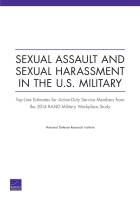 |
| Read The Report |
This report provides initial top-line estimates from the resulting study, the RAND Military Workplace Study (RMWS), which included a survey of 560,000 U.S. service members fielded in August and September of 2014.
Compared to the prior DoD studies, the RMWS takes a new approach to counting individuals in the military who experienced sexual assault, sexual harassment, or gender discrimination. Our measurement of sexual assault aligns closely with the definitions and criteria in the Uniform Code of Military Justice (UCMJ) for Article 120 crimes. The survey measures of sexual harassment and gender discrimination, which together we refer to as sex-based military equal opportunity (MEO) violations, use criteria drawn directly from DoD Directive 1350.2. Compared with past surveys that were designed to measure a climate of sexual misconduct associated with illegal behavior, the approach used in the RMWS offers greater precision in estimating the number of crimes and MEO violations that have occurred. However, recognizing that DoD is also interested in trends in sexual assault, sexual harassment, and gender discrimination, RAND fielded a portion of the 2014 surveys using the same questions as previous DoD surveys on this topic.
Key Findings
RAND Researchers Estimate That, as of Early Fall of 2014, Approximately 20,000 of the U.S. Military's 1.3 Million Active-Duty Members Experienced One or More Sexual Assaults in the Past Year
- This figure includes assaults by other service members, civilians, spouses or others.
- It represents 4.9 percent of active-duty women and 1 percent of active-duty men.
An Estimated 26 Percent of Active-Duty Women and 7 Percent of Active-Duty Men Experienced Sexual Harassment or Gender Discrimination in the Past Year
- Close to one third of women in the Navy and Marines experienced one of these violations in the past year. The majority of these violations involve experiences consistent with a sexually hostile work environment; however, significant numbers of women also indicate having experienced gender discrimination.
- We estimate that in the Army, almost 1 in 12 men experienced such a violation in the past year; in the Navy, it was nearly 1 in 10. For men, the largest source of problems stem from sexually hostile work environments, not gender discrimination or sexual quid pro quo.
The Study Found Significant Differences in Rates of Sexual Assaults and Sex-Based MEO Violations by Branch of Service
- Fewer Air Force men and women experienced these events than their counterparts in the other services.
- In forthcoming reports, RAND will investigate if some of these service differences are attributable to differences in member demographics (e.g., age and education levels), cultures, or policies across services.
Trend Data Suggest That Rates of Unwanted Sexual Contact and Sexual Harassment for Active-Duty Women Have Declined from 2012; Rates for Both Men and Women Are Lower Than in 2006, But About the Same as in 2010
- We estimate that the percentage of active-duty women who experienced unwanted sexual contact as measured by the WGRA methods declined from 6.1 percent in 2012 to 4.3 percent in 2014; the same percentages for men did not see a statistically significant change (1.2 percent in 2012 compared with 0.9 percent in 2014).
- Similarly, estimates for the percentage of women who experienced sexual harassment in the past year declined significantly from 23.2 percent in 2012 to 20.2 percent in 2014; for men, the percentage in 2014 (3.5 percent) was not significantly lower than in 2012 (4.1 percent).




